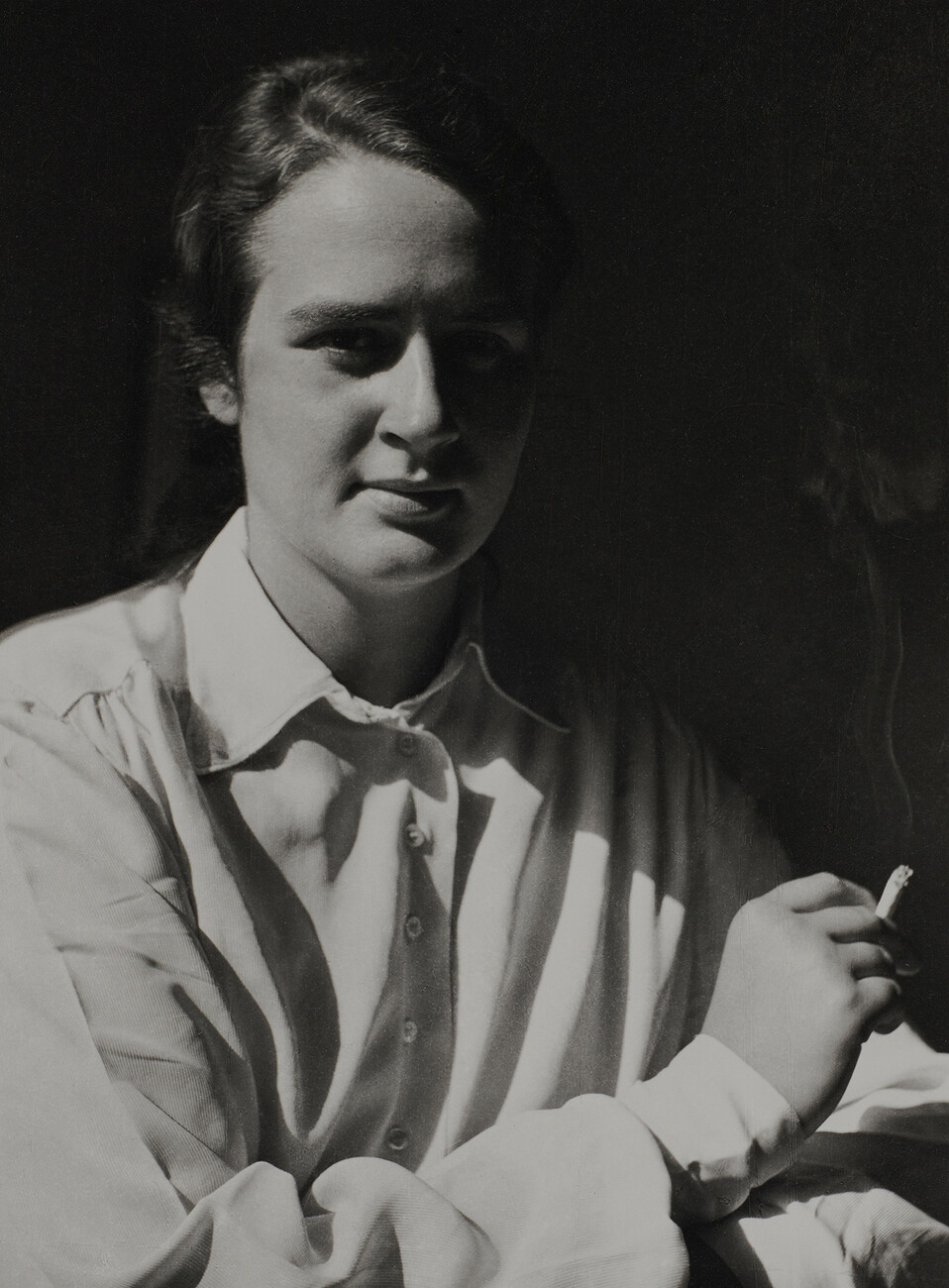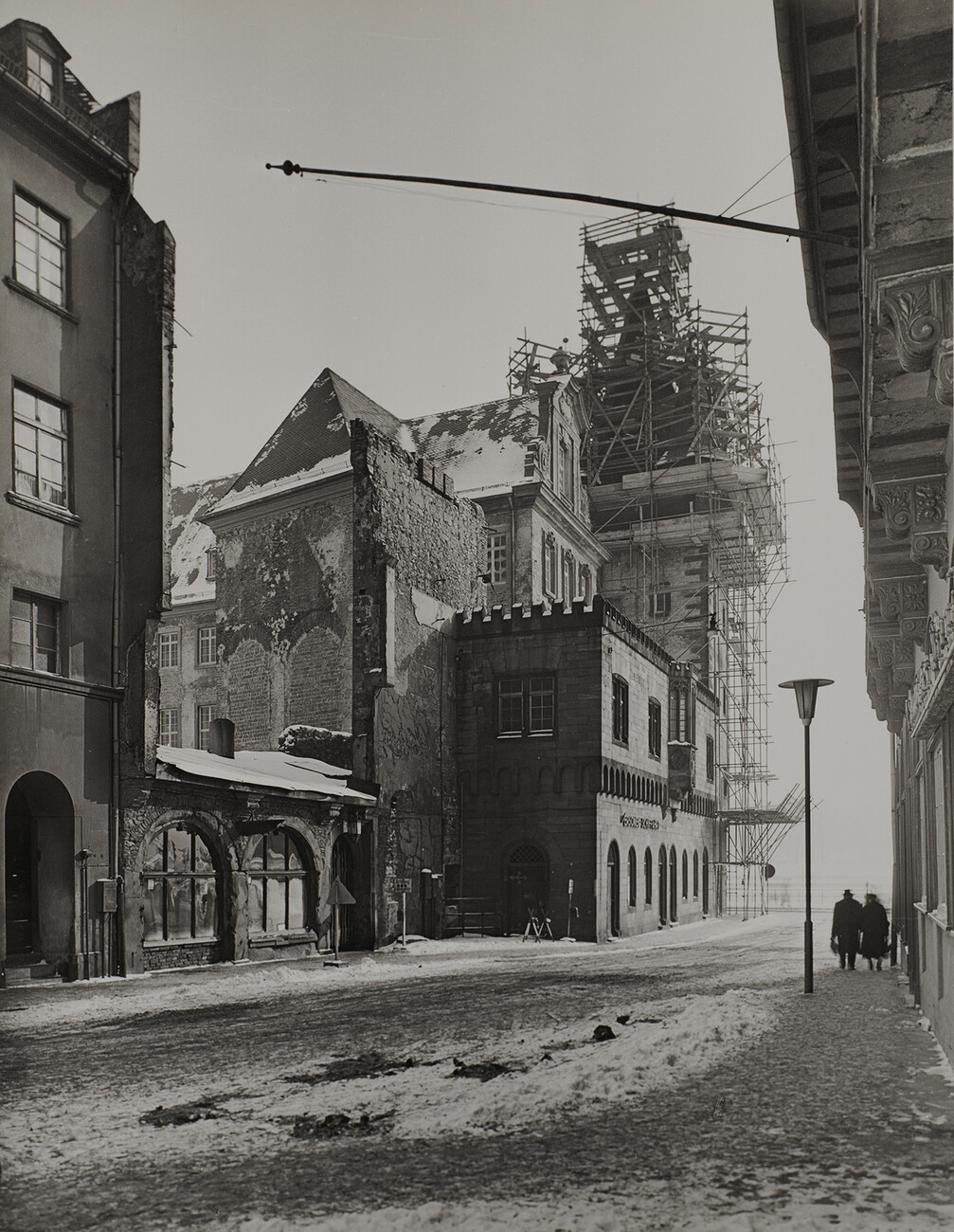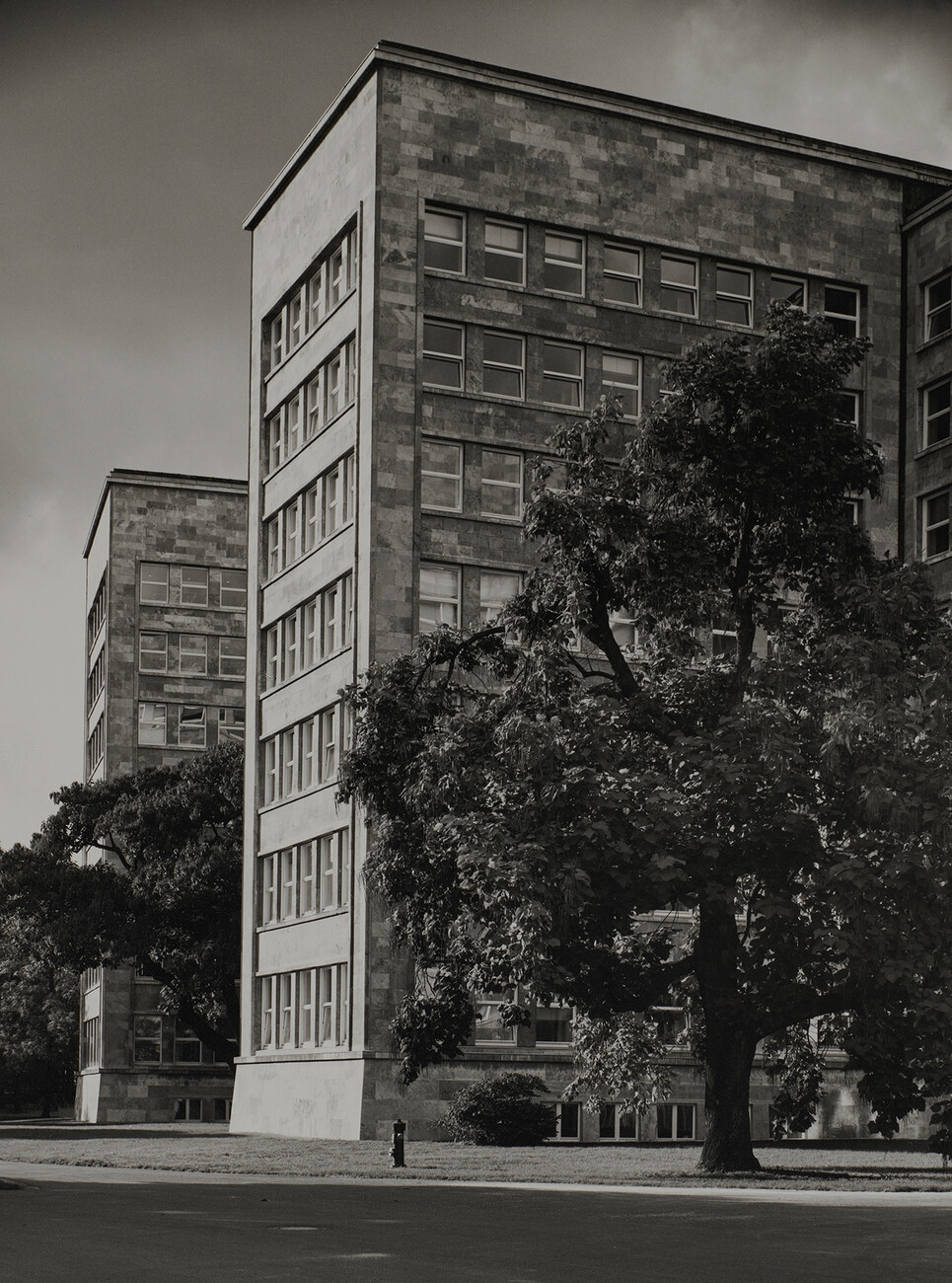Reverberating images
Ms. Edelmann, what fascinates you so much about photography?
Ursula Edelmann: Well, actually I wanted to study music, become a pianist and play in an orchestra. But from an early age I was interested in photography, in part due to my father. He was the chairman of an insurance company and an avid filmmaker. When I saw my father for the last time after the end of the war in 1945, he advised me against making photography my profession. But undeterred shortly afterwards I drove to the Potsdam photographer Max Baur to be interviewed for the job of trainee photographer. We talked for a while and then suddenly he said: “You can start on Monday.” Not that I had any references to show at the time. I did a three-year traineeship in his studio.
During my research for this interview, I read that after your traineeship with Max Baur you were especially well qualified for architecture photography. Why was that the case?
Ursula Edelmann: Before Potsdam was destroyed in the war Max Baur had photographed the city and made postcards featuring the motifs. His postcard business was an important source of income for him. During my internship there we documented the war-ravaged Potsdam and it was then that I learned a lot about architecture photography.
For Max Baur light was essential to photography. How should I conceive of your work in this respect?
Ursula Edelmann: He always said there is only one sun. When we photographed sculptures there was always a main light and the rest was only brightened, say with cardboard. Max Baur called himself a "light sculptor". His shots were very calm and precise in line with the New Objectivity style. It was important to understand the technical side. When I had architecture photographs to take, the first thing I did was to go to the location to determine when the daylight was best. And the weather also had to be right. I didn’t take the photo until everything was perfect – so it was a lengthy process. In Frankfurt/Main I took photos for the Municipal Building Department and would just get a piece of paper with a note of the building on it. It was up to me how I took the photo.
What led to you moving from Berlin to Frankfurt?
Ursula Edelmann: A job advertised on RIAS Berlin (a radio and TV station in Berlin’s American Sector). They were looking for a photographer to take shots of the exhibition booths in Frankfurt/Main. That’s how it started. I was lucky to get an American inter-zone pass but had to travel illegally on the route from Berlin-Steinstücken to Frankfurt/Main over the Green Border. During this time in Frankfurt, I photographed the exhibition booths at night and my friend Liselotte, who I’d met while a trainee and had also come to Frankfurt from Potsdam, collected the film, developed them and made the enlargements. Then we could take the photos straight to the respective booths the next morning. After a while I set myself up as a freelance photographer. When I think about it today it was completely crazy. I didn’t have a dark room, just a furnished room and a camera, a Rolleicord that my mother gave me, and an old wooden camera that had already been out of date when I started the traineeship. Luckily my landlord let me use a corner of the cellar to set up my enlarging equipment and I rinsed the images in the laundry room. I was allowed to divide off part of the laundry room as a dark room and worked there.
What advice did Max Baur give you when you went freelance?
Ursula Edelmann: He didn’t realize I had at first. He stayed in Potsdam for a while. Later I visited him and showed him some of my photographs. He continued to be very supportive, for example lending me expensive lenses that I couldn’t afford.
Initially, you worked in black and white. Is that correct?
Ursula Edelmann: To begin with, yes, but then ektachromes were needed for a job for the Städel Museum, in other words, large-format color slides. I taught myself how to produce slides as that wasn’t covered in my training under Max Baur. He rejected color photography and only colored some of his black-and-white shots afterwards, but I didn’t like that. My last color slide with a large-format camera was a picture of the Olivetti building in Frankfurt.
Which method do you prefer, black-and-white or color photography?
Ursula Edelmann: I can’t say. Photographer Barbara Klemm whom I greatly admire once said "black and white is color enough ". That is no doubt true but I don’t want to exclude color entirely
You needed a wide range of equipment for your work. What did that include?
Ursula Edelmann: The cameras, then tripods and lights – initially I carried that all myself from one place to another or transported it on a bike. During my work in the Städel Museum I was fortunate enough to be able to store my lights in a room there and this was also possible in the Goethehaus. I had different cameras for the different sizes (of picture). The smallest one I used to photograph buildings was 6 x 9, the larger ones were 9 x 12 and 13 x 18.
And then back to the lab.
Ursula Edelmann: Exactly, to develop the black-and-white films and make enlargements. Always accompanied by music. The dark room was my private space where I could listen to music and nobody was allowed to disturb me.
Was there a composer you especially enjoyed listening to?
Ursula Edelmann: Well, Mozart of course. And Beethoven. I listened to entire operas. My enlargements all came about with music. During my training under Max Baur in Potsdam we often went to concerts in the Neues Palais in Park Sanssouci.
I find that a really nice connection because somehow your photos reverberate through the depth when you look at them. They are very vivid and the details are so precisely depicted that you can almost grasp them.
Ursula Edelmann: I’m glad you should say that.
What it your intention from the start that the details should be so precise?
Ursula Edelmann: It was my intention to produce the photographs as well as possible, every motif from architecture through to technology. Max Bauer also taught me to master this variance. There was nothing he could not do in photography.
Your training gave you a foundation but after that what you learned was of your own doing.
Ursula Edelmann: That’s right. However, Max Baur as my teacher simply awakened the ability that was inside me. Needless to say, as a freelance photographer I learned a lot of new things.
Is there one theme in Frankfurt/Main to which you always return?
Ursula Edelmann: Of absolutely. For one thing the Dominican Monastery; I met my husband in the central isle of the destroyed church. I was photographing the building for the Municipal Building Department and my future husband was at the time studying history of art and had been commissioned to document in photographs the objects of art historical importance like gravestones. In the Carmelite cloisters I used to photograph sculptures and metal installations and also exhibited a large number of my pictures there for the first time in 2002. This also led to the production of an illustrated book – "Ursula Edelmann Fotografien: Architektur und Kunst in Frankfurt von 1950 bis heute". (Ursula Edelmann Fotografien: Architecture and Art in Frankfurt from 1950 until today). At the time supported by the owner of the Adox Fotowerke Dr. C. Schleussner GmbH because the images were produced on Adox films. The Dominican monastery and Carmelite cloisters are places I would not want to miss in Frankfurt/Main.
In recent decades the city of Frankfurt/Main has altered tremendously. What do you think of the current developments in architecture?
Ursula Edelmann: I find some things wonderful, others less so – however, it was not my job to talk about architecture but to photograph it. What I liked about the rebuilding effort after the War was that a portion of the construction costs were made over to artists and consequently a number of works were created on the buildings. I got to known many artists during this time such as the metal sculptor Hans Oskar Wissel, and photographed their work.
You not only photographed art in museums and studios but also in the public realm – can you give me an example?
Ursula Edelmann: The best-known ones are doubtless the images of the "Hammering-Man", a sculpture by Jonathan Borofsky depicting the silhouette of a worker hitting a workpiece with a hammer. I also photographed the lying female figure by Willi Schmidt on the Fressgass. Sadly, some of the works no longer exist today like the wonderful murals by Benno Walldorf.
You also took many photographs in Spain, France and Italy. How did that come about?
Ursula Edelmann: My husband did his doctoral thesis on Romanesque Madonnas and crucifixes and we traveled a lot in these countries for his research work. Later he was given a post at what was then the Bundesstelle für Entwicklungshilfe (Federal Agency for Development Aid, or BfE) and he assembled a comprehensive library and archives there. His art history research work still exists but unfortunately there has not been an opportunity so far to completely reappraise it.
Your portfolio also includes design photography like the images of radio prototypes by architect Walter Schwagenscheidt from the Kronberger Werkstatt für Gestaltung. The designs triggered quite a discussion at the time. Why was that?
Ursula Edelmann: The forms of the six designs by Walter Schwagenscheidt, Tassilo Sittmann and Helmut Dornauf were extraordinarily modern, they had designed housings with a futuristic look that were colorful and had abstract forms. But they were not shown in the Consumer Electronics Fair in 1953 because they were considered too radical for their time. Then shortly afterwards a successful design by Braun was launched (editor’s note: The combined radio and record player SK 4, also known as "Snow White’s Coffin", design by Hans Gugelot, Herbert Lindinger and Dieter Rams). So, in a way my photos document a phase of the development back then.
What would you advise budding photographers?
Ursula Edelmann: The main thing is having the right light and dealing with the object you are photographing. A good photograph depends on these skills.
Is there a current analog or digital device that in retrospect you would have liked to have had for your work?
Ursula Edelmann: No, I was completely satisfied with what there was. And over time I developed a certain sense and can still tell today whether a photograph was taking using an analog or digital camera.
Have you taken digital photos yourself?
Ursula Edelmann: Yes, with a digital Leica. One of the shots is on show in the Building Supervisory Authorities. Its director at the time, Dr. Michael Kummer, bought many of my works and also commissioned me to photograph new buildings.
Is there a motif you would like to photograph?
Ursula Edelmann: No, I don’t take photos any more.
Are there works by past colleagues of yours that you still enjoy looking at today?
Ursula Edelmann: Absolutely, there are many. I would name just the works by Barbara Klemm or Georg Christian Dörr with whom I exhibited works in 2015.
Ursula Edelmann
Ein Leben für die Fotografie (A life for photography)
16 June until 10 July 2021
KunstRaum Bernusstraße
Bernusstraße 18
60487 Frankfurt am Main
Thursday: 2:30 p.m. to 8 p.m.
Friday: 2:30 p.m. to 6:30 p.m.
Saturday: 11 a.m. to 2 p.m.
Curators: Rudi Feuser and Stefanie Wetzel, Pangallery, Frankfurt am Main
























